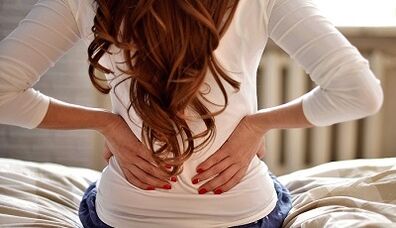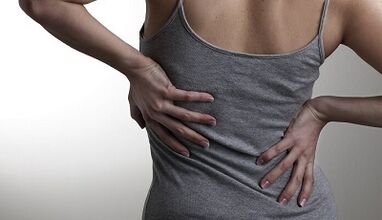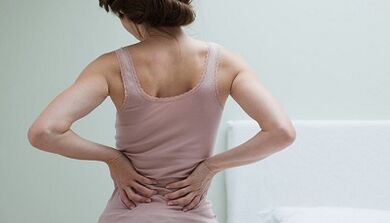
About 80 percent of adults face pain in the lower back and if you have such a problem, know that you are not alone.This is fixing.The main thing is to understand the origin of the pain, but there can be many factors.We have collected the main causes of lower back pain that can cause back difficulties.How to relieve the disease?There are methods.
Back pain can occur at any age and with any physical fitness.So, there is a stupid, constant or periodic pain, but a sudden acute attack happens, after which it is difficult to move a person.Pain can occur sharply due to the severity of lifting, may develop with age due to changes in the spine or as a result of an incident.A sedentary lifestyle is also an important reason for the development of lower back pain.Especially when everyday life is not diluted with physical activity (training, pool, fitness, yoga).
In most cases, lower back pain is acute and short or less expressive, but lasts from several days to several weeks.In such cases, one still does not lose their activity, the ability to move and serve in everyday life.
Sayborne pain is a pain that does not pass after an acute period and lasts for 4 to 12 weeks.If the pain is still preserved after this period, it is called chronic.It happens that treatment can help get rid of chronic lower back pain.But in some cases the pain remains, despite medical and surgical treatment.
So, lower back pain, the causes of which are often due to age and are associated with wear in the joints, discs and bones of the spine or mechanical pain:
1. Stretching the links
Therefore, you can experience acute back pain.Stretching occurs due to an incorrect turn or rise of something.As well as the weight of lifting or excessive stretching.Such conditions can cause cramps in the back muscles, which also carry pain.
2. The area of the intervertebral disc

One of the most common causes of lower back pain.The manifestation of this is the loss of the integrity of the disks, cracks appear.In a young and healthy back, the disks allow you to bend, untie and twist its bottom.But over the years, the elasticity of the discs has decreased and they lose their ability to absorb shock.
3. Hernia
It may occur due to the cultivation of a large load, a disorder of the posture, accidents, sports injuries, etc.In the center of the lumbar disc is fluid, for various reasons it can come out and cause irritation to the nerve roof that is nearby.There are many nerve fibers in the wall of the disc, and the rupture of the wall can cause severe pain.
4. Radiculopathy
This condition occurs due to compression, inflammation and/or damage to the spinal cord.In addition, the pressure on the nerve spine leads to pain, numbness or numbness, which apply to other parts of the body associated with this nerve.The problem may occur if the central spinal canal is narrowed or the hernia secures the nerve root.
5. Sciatica
Feeding the sciatic nerve that passes through the butt and spreads down the back of the leg.This compression causes shock or burning pain in the lower back in combination with butt pain.And also in exceptional cases where the nerve is pressed between the disc and the adjacent bone, one may feel numb and a serious weakness in the legs.By the way, this condition occurs due to a tumor or cyst that presses the sciatic nerve or its roots.
6. Stynosis of the spine
In the case of this disease, a person in addition to lower back pain may encounter numbness or weakness of the legs when walking.And also with loss of sensitivity.
7. Scoliosis and other skeletal disorders

One usually does not experience special problems with the curvature of the spine before the onset of middle age.
Low pain is rarely associated with serious illnesses.But you still need to keep up with their existence in order to have time to consult a doctor in a timely manner.You can beat the diseases listed below only with medical help.This:
1. Infection
These are not the causes of lower back pain, but the vertebrae (osteomyelitis), the intervertebral discs (dicite) or sacral legal joints (saroileitis) can affect.
2. Tumors
Sometimes the tumor occurs right in the back (and at certain stages, of course, there will be pain and other symptoms), but most often these are metastases that spread due to cancer of other parts of the body.
3. The Syndrome of the Tail of the Chernene
The disease, sometimes accompanied by rupture of the disc.This is due to the fact that the disk material is pressed in the spinal canal and compresses a bunch of lumbar and sacral nerve roots.In connection with this disease, one can have problems with urination and intestines.
4. The abdominal aortic aneurysm
This happens when a large blood vessel that supplies blood from the abdominal cavity, pelvis and legs, expands unusually.In addition, lower back pain may be a signal that the aorta has increased and there is a risk and rupture.
5. Kidney Stones
Stones can cause acute pain in the lower back (usually on one side).
The other factors and causes that can cause lower back pain:
- Inflammatory joint diseases.For example, arthritis, spondylitis, inflammation of the vertebrae.
- Osteoporosis.It is a bone disease that is accompanied by a decrease in bone density and strength, which can lead to vertebrae fractures.
- Endometriosis.A female disease that can be accompanied by pelvic and lower back pain.
- Fibromyalgia.Pain syndrome accompanied by muscle pain and fatigue.It is chronic.

What to do with lower back pain?
First, you need to carefully deal with the causes of pain.What can help with a disease will not make it easier (and possibly even worsen) another.In some cases, emergency hospitalization is required.Therefore, be sure to listen to your body's signals and, if necessary, consult a doctor or take appropriate measures.
Ways to deal with lower back pain:
1. You can rest your back after a specified period of time
Many back problems can be solved (or facilitated) by avoiding intensive activities.But it is not recommended to relax for more than a few days, as too long inaction can complicate treatment.
2. Limited activity
This means staying active, but avoiding actions and positions that increase pain.For example, if the long periods of sitting in the car or at the table sharpen the pain, then set the timer to get up every 20 minutes and walk or stretch carefully.The minimum of actions and positions that worsen the pain will help prevent or weaken painful cramps and accelerate the recovery process.
3. Therapy with cold/warm
In order to relax the tense muscles and improve blood flow, warm bath, heating pads, packages are suitable.If back pain has occurred due to inflammation, then you can try applying ice or cold compresses to reduce the swelling.It is important to protect the skin during procedures to prevent tissue damage.
4. Analgesic drugs
The most common without a prescription are anti -inflammatory drugs that relieve lower back pain, the causes of which are swollen nerves or muscles.And also in some cases the analgesic can help.Effective B vitamins, muscle relaxants, various gels and ointments.
5. Physiotherapy
It is usually part of the treatment of lower back pain.It is useful to get involved in stretching: the more mobile muscles, the better the back can move without injury.It is recommended to start the muscles of the small discharge for 20-30 seconds on the lower back, buttocks, hips, legs and stopping stretching if it hurts.
And you should also strengthen the muscles of the abdomen, hips and buttocks that support the spine.Low exposure aerobic exercises increase blood flow and contribute to curative injuries without concussion.For example, you can get involved in fixed bicycles and elliptical simulators, walk and swim.
In fact, any exercise that maintains the heart cycle is usually useful for the body for a long time.Regular physical activity is necessary to maintain the freedom of movement and flexibility of a healthy spine.


















